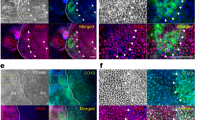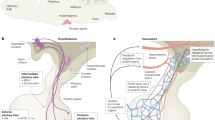Abstract
In the present study, we have adopted the model of Triplett1 to reinvestigate the timing of development of immunological tolerance to self-organ-specific antigens. We have removed pituitary or eye2 anlagen from frog embryos before development of the immune system and returned them at a later time as differentiated organ implants to their now immunocompetent larval or adult original owners. If immunological tolerance to these putative organ-specific self-antigens occurs at an early and fixed time period, then organ-deprived hosts, lacking the opportunity to become tolerant, would be expected to reject such implants1. Our results show that self-implants were never rejected whereas control allogeneic implants were usually rejected by larval hosts and were always rejected by adult hosts. These data, which contrast with those reported by Triplett, suggest that frogs, and perhaps other higher vertebrates, can become tolerant to self-organ-specific antigens throughout life.
This is a preview of subscription content, access via your institution
Access options
Subscribe to this journal
Receive 51 print issues and online access
$199.00 per year
only $3.90 per issue
Buy this article
- Purchase on Springer Link
- Instant access to full article PDF
Prices may be subject to local taxes which are calculated during checkout
Similar content being viewed by others
References
Triplett, E. L. J. Immun. 89, 505–510 (1962).
Rollins, L. A. & Cohen, N. in Development and Differentiation of Vertebrate Lymphocytes (ed. Horton, J.) 203–214 (Elsevier, Amsterdam, 1980).
Kobel, H. R. & Du Pasquier, L. Immunogenetics 2, 87–91 (1975).
DiMarzo, S. & Cohen, N. Immunology 45, 39–48 (1982).
Nieuwkoop, P. D. & Faber, J. Normal Table ofXenopus laevis (Daudin), 1–252 (North-Holland, Amsterdam, 1967).
Shumway, W. Anat. Rec. 78, 139–147 (1940).
Taylor, A. C. & Kollros, J. J. Anat. Rec. 94, 7–23 (1946).
Rahi, A. H. S. & Garner, A. Immunopathology of the Eye, 1–343 (Blackwell Scientific, London, 1976).
Asa, S. L., Bilbao, J. M., Kovacs, K., Josse, R. G. & Kreines, K. Ann. intern. Med. 95, 166–171 (1981).
Topliss, D. J. & Volpe, R. Ann. intern. Med. 95, 227–229 (1981).
Author information
Authors and Affiliations
Rights and permissions
About this article
Cite this article
Rolling-Smith, L., Cohen, N. Self-pituitary grafts are not rejected by frogs deprived of their pituitary anlagen as embryos. Nature 299, 820–821 (1982). https://doi.org/10.1038/299820a0
Received:
Accepted:
Issue Date:
DOI: https://doi.org/10.1038/299820a0
Comments
By submitting a comment you agree to abide by our Terms and Community Guidelines. If you find something abusive or that does not comply with our terms or guidelines please flag it as inappropriate.



